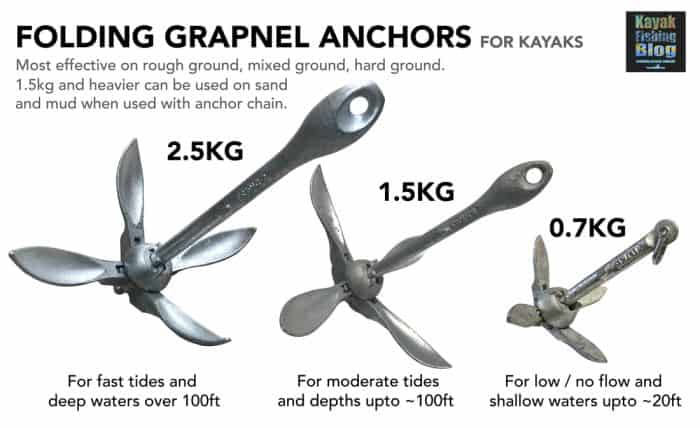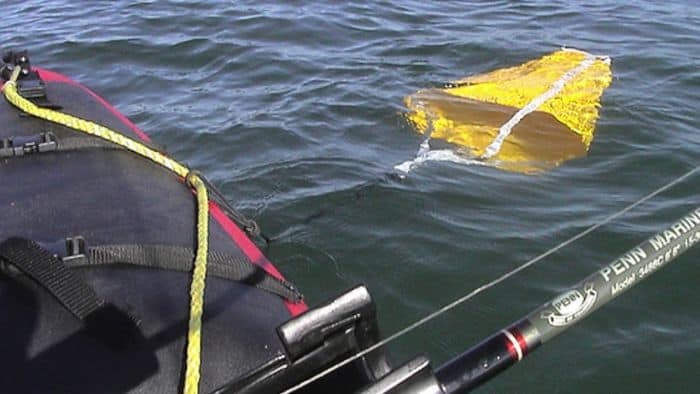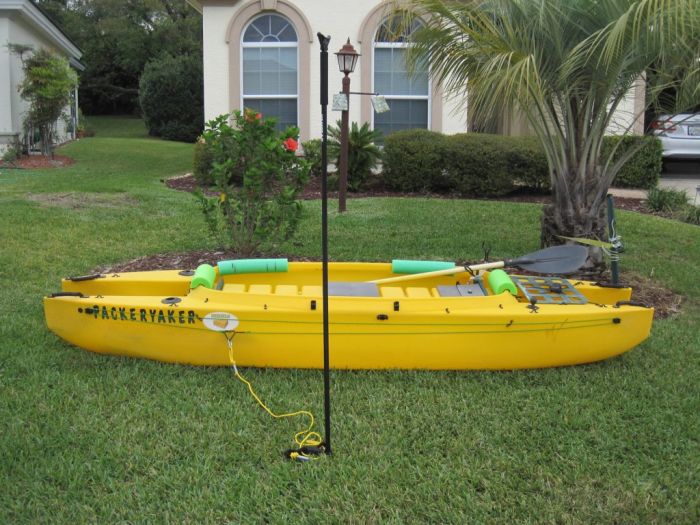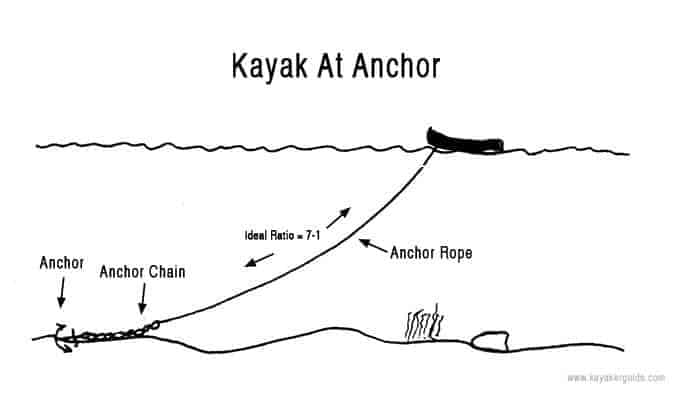To keep your boat still and fish in the exact area you want, the weather conditions or the tide movement should be perfect, and there should be no current. But do these ideal conditions ever exist? Rarely.
You need an anchor for kayak fishing if you don’t want to drift away from the desired fishing spot due to water current and wind. Without an anchor, you would have to keep paddling to stay in your favorite spot, which will quickly tire you out, and you won’t be able to focus on fishing or enjoy it.
If you don’t anchor and keep drifting away, soon, your fishing line won’t reach the exact area you want to cast into.
Why Do You Need An Anchor?
To remain stationary, why else? We agree that there are a few options to stop your kayak’s movement, like the stake-out pole or the drift chute (more on these later), but a more preferred way is to throw in an anchor.
Some other unreliable methods include taking the support of a boulder or a tree branch and finding shallow waters with lots of sand. These methods are heavily dependent on the structure of the water body you are planning to fish in as rocks, boulders, trees, or sand might not be available.
Just like an anchor works for boats and ships, it can easily stop your kayak from drifting away in both light and heavy currents. And if your kayak isn’t drifting away, then your fishing line would remain a lot more stable and increase your chances of catching a fish.
Lines with baits that float too fast reduce the catch rate significantly as the fish won’t chase it. Even though your kayak is a lot less detectable than a boat, the fish can still detect it. Add to that some rapid speed, and you can be sure that you will be taking home next to nothing that day.
Thus, the objective is to be as still as possible in the water you are fishing. A major point to remember is to ALWAYS throw in the anchor from the bow or stern of the kayak and NEVER from the side. You risk flipping the kayak, and that can pose some serious threat.
Correct Weight Range
Many anglers make the mistake of thinking that they can use anything as an anchor. They feel that any heavy weight is okay to stop a lightweight kayak dead in its tracks. As a result, we see all sorts of things being used like homemade bricks with ropes, dumbbells, and homemade concrete mud weight.
However, using too heavy an anchor isn’t safe. Firstly, a heavy anchor will go down extremely fast and exert a lot of force on your hands and the kayak simultaneously. This might topple the kayak, and you will be swimming instead of fishing (assuming that you know how to swim).
Secondly, really heavy anchors will drag along the pond, lake, or river bed and damage the bottom. As an angler, it is your responsibility to keep the habitat as is or improve it instead of doing something that might damage it. Therefore the ideal anchor weight is between 1.5-3 pounds.
A 3-pound anchor is the maximum you need for your kayak for really heavy currents, whereas a 1.5-pound anchor is sufficient if you are fishing in flat waters with little to no current. A folding anchor works well as the folds open up and firmly hold the ground, locking the anchor in its place.

Source: kayakfishing.blog
Positioning Your Anchor
The age-old question asked time and again is from where exactly should I throw my anchor? Before we discuss the bow and the stern, let us remind you again that it is NEVER a good idea to throw it from the sides due to the dangers mentioned in the above section.
Throwing the anchor from the bow makes it float backward a bit before it settles down, and then you can start fishing on the left or right of the anchor line depending on its position. It is easier to pull in the anchor when you are done as compared to throwing it from the stern due to the natural angle.
However, it significantly reduces your playing field and increases the chances of line entanglement with the anchor rope. Either your hook might get stuck, or when the fish bites and tries to swim away, it may inadvertently entangle your whole line around the anchor rope.
There have been several instances where many anglers had to lose their fishing gear due to the exact same scenario. Thus, in our opinion, the best place to throw in the anchor is behind the kayak i.e., from the stern.
Now you have a large area to throw in the line from the back left portion of the kayak to the back right. That is a wide angle! Also, since the anchor tends to float backward before settling down, the chances of your line getting entangled are also reduced.
The only downside is that pulling the anchor out from the stern area is a bit of a problem as either you’ll have to turn the kayak around completely to get a natural angle or you’ll be pulling with your hands and body being at an awkward angle.
Storing The Anchor
Most kayaks have built-in places or compartments for storage. Wherever you store your anchor, it should be easily accessible, and nothing should fall in the path of retrieving it. If you have fishing gear or other stuff obstructing its course, then there are high chances that your anchor rope will get entangled.
A good place to store the anchor is in the nearest compartment to the front or back, where you can reach it easily by just extending your hand. It is crucial that reaching the anchor or throwing it out doesn’t require you to move much because you risk toppling over and falling into the water.
Kayak Anchor Alternatives
Though an anchor should be your best buddy for stopping your kayak from drifting away, it doesn’t hurt to know about a few other alternatives, right? Moreover, you can team up one of these with your anchor for better efficiency.
1. Drift Chutes
You might find yourself quite frequently in a situation where you do not want your kayak to be entirely still but rather crawl. Here a drift chute would slow down your kayak the same way parachutes slow down race cars. The only difference is that the chute also collects water to slow down.
The drag exerts a significant force opposite to the direction of the current. Drift chutes are best suited for low to medium water currents as in waters with no current, they would just float behind you.

2. Stake-Out Pole
If you are paddling in relatively shallow waters, then you might want to use what is known as a stake-out pole. It is nothing but a long stick with a pointy end that you can push into the ground under the fancy name.
It is quick to deploy and more straightforward to use than meddling with an anchor and tossing it around. However, its use is strictly limited to shallow waters. Anglers use it by attaching it to an anchor trolley or pushing it through scupper holes of their kayak.
However, we DO NOT recommend using scupper holes as they are the weakest part of your kayak or a boat, and continually stressing it will induce cracks. Stake-out poles impart a substantial ground to your kayak, and don’t let it move anywhere.
Also, as compared to an anchor, you sit still in the exact area you want to fish. When you use an anchor, there is a distance between your kayak and where the anchor sits due to current or wind action. This may put you out of range from the area you wanted to cast in.
Another advantage of using a stake-out pole is that the pointy end can be used as a weapon to fend off unwanted predators in the water. A significant disadvantage of a stake-out pole is that it is not that much space friendly and portable like an anchor.
Another problem is that it often gets in the way of where you want to fish. Though there are lesser chances of your fishing line entangling around a stake-out pole than an anchor line, still your hands don’t move as freely, and you might always feel bothered by a rod sticking out from your boat.

Source: wavewalk.com
Is An Anchor Trolley Necessary?
An anchor trolley is an extension of your anchor setup, gets attached to the side of your kayak, and is quite helpful when you want to change the position of your anchor line with respect to the wind position without having to pull the anchor back completely.
Suppose you want to move the anchor line from one side to another, then you’ll have two options. Either to completely pull in the anchor and drop it again on the other side or to pull it partly to lift it off the bottom and then dragging it to the other side.
Both of these methods are clumsy. Now, imagine a situation where you have cast the anchor from the bow area, and your line is up-current. But now you want to move the anchor line off to the stern, then an anchor trolley will quickly allow you to do so without much movement and risking detection by the fishes.
The anchor trolley works as a mobile anchor cleat so that you can change the angle of your boat at will whenever the wind direction or tide changes.
Anglers often use two anchor trolleys (one on each side) to get even more anchoring positions. Using an anchor trolley is quite easy, and there is no reason why you shouldn’t have one on your kayak. You need more reasons? Here are a few right off the top:
1. One Anchor Trolley Equals Several Anchor Cleats
You simply cannot rely on just one anchor cleat at the perfect position. To position your kayak where and how you want needs you to have a certain amount of flexibility. You need to read the weather and water conditions and then decide on a connection point.
If you don’t use an anchor trolley, your other option is to use multiple anchor cleats attached all-around your kayak port and starboard sides, which is certainly not an optimal solution.
2. Increased Flexibility
With an anchor cleat, you do not have many options whenever the wind direction changes, or your kayak is drifting to the anchor’s opposite side due to the current. With an anchor trolley, you can make adjustments at a moment’s notice.
3. Can Work With Many Anchor Types
Whether you are using a 1.5-pound anchor in relatively calm water, a 3-pounder in a strong current, or a drift chute or a stake-out pole, chances are your anchor trolley will work perfectly with these and not render itself useless due to compatibility issues.
Such versatility feels quite empowering when you need to make any changes in the middle of a fishing trip.
4. Extremely Easy To Use
With so many benefits of using an anchor trolley with your anchor, it is normal to think of a catch. For most anglers, it is the question of installation and ease of use. Watch any DIY video or instructions that come along your purchase, and you will be ready to go out fishing within a few minutes.
There is nothing complicated that you need to worry about. You add the anchor rope to a ring from the anchor trolley setup, and in the event your anchor rope gets stuck, just detach it.
5. Budget-Friendly
And lastly, it comes down to the price. Just like an anchor kit or a stand-alone anchor, most anchor trolleys are inexpensive. Considering the benefits you get, the price is a definite steal.
How Much Rope Do I Need For A Kayak Anchor?
Since a kayak is always devoid of space compared to a boat, you want to make the most optimal use of the space available. Thus one of the most unnecessary things you can do is carry more anchor line than you need. There is no particular length we can quote that you can use in all waters.
A rule of thumb is to carry minimum seven times the anchor line for every foot of water depth. This is called the ‘scope.’ For example, if you are fishing in water 15 ft deep, then you need a minimum of 15 ft x 7= 105 ft of anchor line. The maximum amount should be ten times the water depth.
Why so much, you ask? Because your kayak or boat is not going to stay strictly on top of where you drop the anchor. Wind action and water current will make it drift away. That is the whole point of why we are using an anchor in the first place, remember?
If your anchor drops vertically below right where you are, and your kayak doesn’t move at all, the chances are that you don’t need an anchor in the first place in such water or weather conditions.
Also, carrying more anchor line than 105 ft in the above example would mean putting extra weight on your kayak, and carrying a lesser length would mean that you still risk drifting away.
Another risk is of disturbing the balance of your kayak if your anchor doesn’t touch the bottom for some reason and dangles in between. This puts extra weight on one side of the kayak.

Source: kayakerguide.com
Conclusion
Though stake-out poles and drift chutes are good anchor alternatives, they have limited use. An anchor with an anchor trolley that provides us the flexibility of changing the anchor line position is the most optimal setup, which makes sure you get the most out of your fishing experience.
Keep the things we have discussed above in mind related to proper anchor usage, and you will see how fantastic anchoring is. We sincerely hope that you enjoyed the article. In case of any doubts, queries, feedback, or suggestions, please write to us. We love hearing from you.
